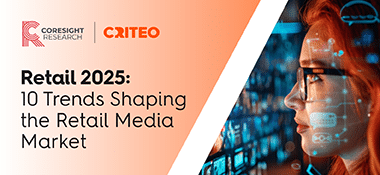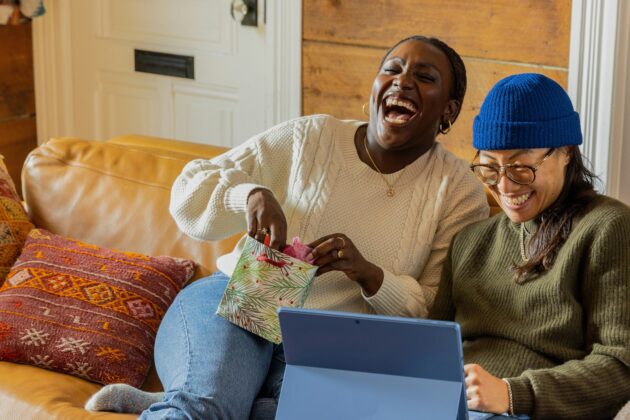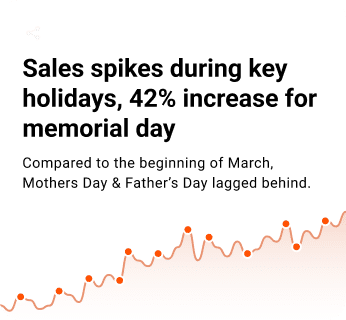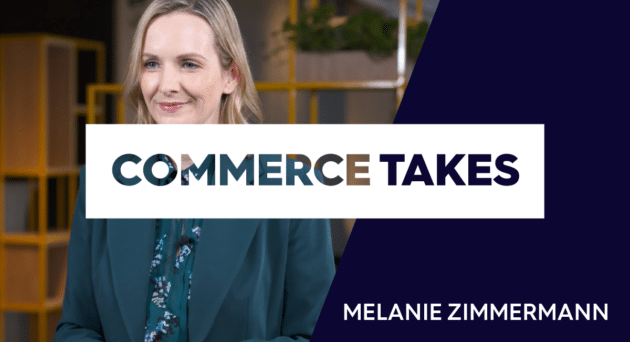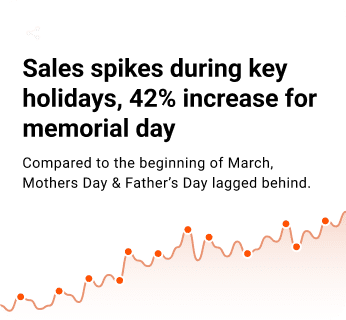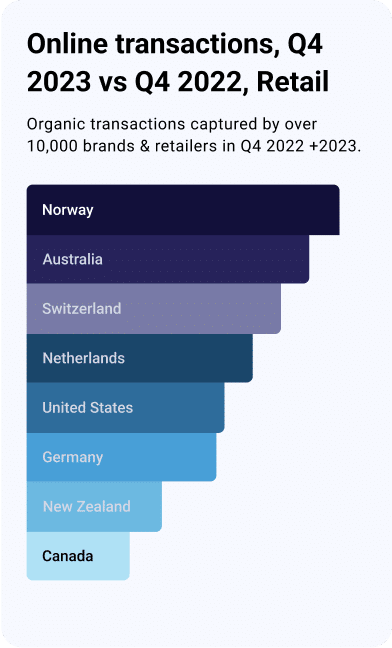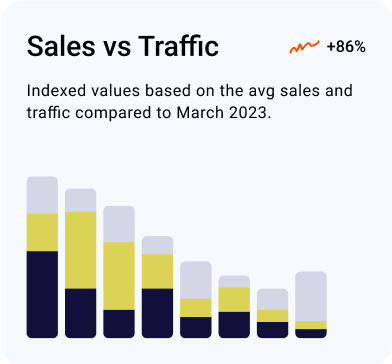As a brand selling through retailers, your goal is pretty simple: to sell more stuff.
To do this, you can rely on various organic or paid strategies, but if your retailer partner operates a retail media network, there’s an even more powerful option: sponsored products.
In this guide, we’ll explain what sponsored ads are, how they work, best practices, and more.
What are sponsored products?
Sponsored products are paid advertisements that promote a brand’s specific items within a retailer’s website or app. They’re a lower-funnel tactic designed to capture a consumer’s attention right when they’re ready to buy, including within search results, category pages, and product detail pages.
You’ve almost certainly seen sponsored products in action before—whether you noticed or not. When you search for a product on a retailer’s website, you’ll sometimes see a “Sponsored” or “Ad” tag attached to ad, and that’s the mark of a sponsored product.
While traditional display ads focus on grabbing attention with eye-catching visuals, sponsored products instead give consumers a nudge in the right direction. They’re designed to blend in naturally with organic search results, so they don’t disrupt the user experience for the retailer’s website.
How do sponsored products work?
Like other forms of digital advertising, sponsored products operate with auction-based mechanics.
Just as they might do with search or social ads, brands bid on keywords or product categories relevant to the products they’re selling. When a shopper searches for those terms or browses similar items, the winning bids get their products featured in the relevant high-profile ad slots. The higher the bid, (and the more relevant the product), the better the brand’s chances of appearing at the top of the search results or in prime placements on product or category pages.
For brands looking to drive sales, this digital real estate on retailers is crucial for driving clicks and views. In short, it’s a smart way to get your products in front of shoppers who are actively looking for items just like yours.
The beauty of sponsored product campaigns is that they can be connected directly to sales at the stock keeping unit (SKU) level. That means that for every campaign, brands can see the click through rate, spend, cost per click, sales, and return on ad spend (ROAS) for each individual product.
Retail media can also measure key performance indicators (KPIs) beyond ROAS, including reach and share of voice (SOV). This can help brands track upper-funnel objectives, like building awareness on specific retailer sites.
Brands can also see an aggregate view of those metrics by campaign, by brand, or by category. With solutions that allow you to run multi-retailer campaigns, brands can also see reports by retailer to assess performance across them.
Why use sponsored products?
Sponsored products offer some serious advantages for brands looking to boost their performance in the retail world. They create a direct connection with engaged shoppers, significantly increase product visibility, and provide a level of control and measurability that’s vital for effective advertising. They also excel at delivering strong return on ad spend. In a global survey, an overwhelming majority of both brands (78%) and agencies (83%) across all regions said that retail media spend is somewhat or much more effective in terms of sales impact compared to other channels.i
Let’s dive deeper into why they’re such a valuable tool:
- Boost visibility: They cut through the clutter and put your products right in front of shoppers who are actively searching. They ensure that name brands have the same prime real estate online as they have in-store and help smaller brands be seen.
- Drive sales: 90% of all revenue is from the first page of search results and the first 10 SKUs account for 25-30% of revenue, so a good position on the digital shelf is crucial. By ensuring visibility and targeting shoppers who are ready to buy, sponsored products can significantly improve your conversion rates.
- Increase product discovery: Even if shoppers aren’t specifically searching for your brand, sponsored products can introduce them to your products and grow your customer base.
- Budgetary control: You set your budget and bids, giving you complete control over your advertising spend.
- Brand-safe: Advertising on retailer’s sites uniquely addresses brand safety concerns, as the site content is purely related to products, which eliminates the chance of brands’ ads being positioned near negative or inappropriate content.
- Closed-loop attribution: You can easily track the performance of your sponsored product campaigns, allowing you to fine-tune your strategy and maximize your ROI. This measurability is a huge part of what makes sponsored ads so effective.
What options are there besides Amazon Sponsored Products?
Amazon Sponsored Products is the most commonly known provider of retail media. But it’s not the only one. There are a few individual retailers, like Walmart, that have opted to form their own walled gardens. In addition to these players, there are also networks of retailers that offer retail media with the help of an ad tech partner, like Criteo.
The huge growth in ecommerce in the last few years has brands eager to reach consumers on all the retailers where they are shopping, above and beyond Amazon. With a platform like Criteo Commerce Max, brands can run ads across a wide variety of retailers that they partner with, from large global retailers to regional and specialty retailers. And they can choose to run on just one or several retailers at once.
Sponsored products best practices
Now that you understand the value of sponsored products, how can you ensure your campaigns drive maximum impact? Here are five expert-backed tips to optimize your strategy:
- Choose the right keywords and targeting approach. To ensure your products appear in front of the right audience:
- Target specific search terms that indicate strong buying intent.
- Reach shoppers with category-based targeting
- Use first-party shopper data (available on platforms like Criteo) to refine targeting
- Optimize product listings. Your ads can only do so much if your product pages aren’t compelling. To improve performance:
- Use high-quality images and videos.
- Write clear, benefits-driven product descriptions.
- Ensure competitive pricing and availability.
- Monitor and adjust bids regularly. Sponsored product campaigns use a bidding system, so staying competitive is key:
- Start with automatic bidding to gather data, then shift to manual adjustments.
- Increase bids on high-converting products and refine underperforming ones.
- Adjust bids based on seasonality and demand.
- A/B Test your sponsored ads. Testing different elements of your campaigns can improve performance:
- Experiment with different keywords, targeting settings, and bid strategies.
- Compare results over time and identify the most effective approaches.
- Measure results and optimize continuously. Use key metrics to analyze and improve your sponsored product campaigns:
- CTR (Click-Through Rate): Are people clicking on your ads?
- CVR (Conversion Rate): Are those clicks leading to purchases?
- ROAS (Return on Ad Spend): Are your ads profitable?
- Attribution insights: Use cross-retailer attribution to understand your full impact.
Ready to get started with Criteo?
Sponsored products are a powerful tool to boost your brand’s visibility, drive sales, and reach high-intent shoppers at the right moment. Whether you’re looking to expand across multiple retailers or fine-tune your retail media strategy, Criteo can help you maximize impact with data-driven targeting and cross-retailer attribution.
Talk to a Criteo expert today to explore how sponsored products can help scale your brand’s retail success.
i Source: Criteo, Commerce Media Ecosystem Survey, Q4 2023, N=372



